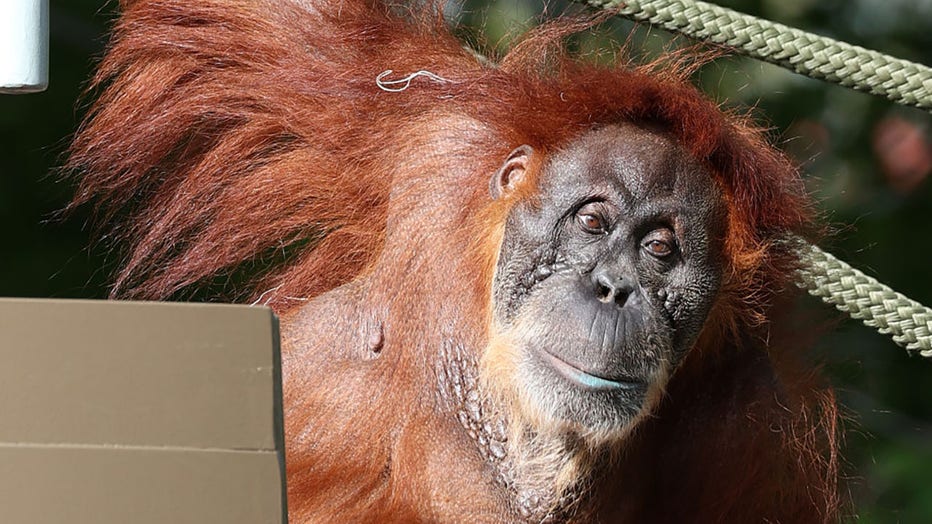Endangered Species Day 2024: 10 of the world’s most endangered animals revealed
Critically endangered Sumatran orangutan born at Sacramento Zoo
Janine Steele, Sacramento Zoo Animal Care Supervisor and Primate Keeper, said the birth was a milestone.
Every year on the third Friday in May, thousands of people around the world participate in Endangered Species Day by celebrating, learning about, and taking action to protect threatened and endangered species.
But, as modern society gets more resource-intensive, natural spaces are shrinking and wildlife numbers are declining, according to the World Wildlife Fund.
The organizations’ 2022 Living Planet Report shows global wildlife populations have plummeted by 69% on average since 1970.
They note that while there have been amazing and inspirational wildlife successes and stories in the past, many animals are still endangered, mostly due to unsustainable human-led activities.
Here are the 10 of the world’s most endangered animals in the wild.
Javan rhino
Javan rhinos have suffered a staggering decline in their numbers due to hunting and habitat loss.
RELATED: The Endangered Species Act turns 50: A reflection on its mixed legacy
The lone wild population of Javan rhinos is one of the rarest of the rhino species – around 75 individuals – which can only be found on the island of Java, Indonesia.
Amur leopard
The Amur leopard is one of the rarest big cats in the world, with only around 100 individuals left in the wild.
Although their wild population seems to be stable and increasing, these leopard subspecies are still critically endangered since 1996.
According to WWF, Amur leopards can only be found in a relatively small region of the far east of Russia and north-eastern China at present.
Sunda Island tiger
The Sunda Island tiger, or the Sumatran tiger, is the smallest tiger subspecies in the world.
They are also very rare, with an estimated 600 in the wild, and are only found on the Indonesian island of Sumatra.
Since the 1980s, the human population of south-east Asia has nearly doubled from 357 million to around 668 million in 2020. And this has had an impact on tiger numbers, which have been shrinking along with their habitats.
Mountain gorilla
The Mountain gorilla is a subspecies of the eastern gorilla, which lives in two isolated populations: high-altitude forests in the volcanic, mountainous regions of the Democratic Republic of Congo, Rwanda and Uganda, and in the Bwindi Impenetrable National Park of Uganda.
According to WWF, the Virunga Landscape has a history of political instability along with high levels of poverty in the region. This poses a substantial threat to mountain gorilla numbers as people have moved into areas closer to these great apes for food, shelter and space. WFF said more than 500,000 people currently live near mountain gorilla habitat.
Tapanuli orangutan
The Tapanuli orangutan species is critically endangered with fewer than 800 individuals in the wild, making them the most endangered great ape species in the world.
The loss of habitat is one of the main threats to its survival as tropical forests are being replaced by agriculture, mining, and hydroelectric and geothermal development.
Yangtze finless porpoise
The Yangtze finless porpoise is the only living freshwater porpoise found in the world.
This aquatic mammal currently resides in the Yangtze River in China and is listed as a critically endangered species.
While the Yangtze river plays a crucial role in healthy ecosystem functioning, years of environmental degradation, overfishing and water pollution in the region are having detrimental impacts on the species, according to WWF.
Black rhino
Between 1960 and 1995, black rhino populations suffered dramatic losses in their numbers due to large-scale poaching, with only around 2% surviving. Around 2% survived the severe onslaught of the past.
As rhino conservation took hold, their numbers have more than doubled across Africa since the 1990s. But, black rhinos are still listed as critically endangered by the IUCN, with around 5,630 individuals in the wild.
African forest elephant
The African forest elephant is found in West and Central Africa. The actual number of wild African forest elephants remains uncertain due to their shy nature, but WWF said the critically endangered species has declined by an estimated 86% over 31 years.
The main reason behind the decline is due to poaching, which is frequent, widespread and intensive, especially in Central Africa.
Sumatran orangutan

FILE - A Sumatran Orangutan named Puppe is seen during her 56th birthday celebration at Toronto Zoo on Sept. 23, 2023, in Toronto, Ontario, Canada. (Photo by Mert Alper Dervis/Anadolu Agency via Getty Images)
The Sumatran orangutan is found exclusively on the island of Sumatra, Indonesia.
RELATED: Sacramento Zoo welcomes the birth of critically endangered Sumatran orangutan
They are listed as critically endangered by the International Union for Convervation of Nature, with less than 14,000 individuals in the wild. Sumatran orangutans face threats including logging, agricultural plantations, and expanding infrastructure development to the illicit pet trade.
Hawksbill turtle
The Hawksbill turtle is one of the seven species of marine turtles and is found in nearshore tropical and subtropical waters of the Atlantic, the Indian, and the Pacific Ocean.
Their numbers are believed to be between 20,000 and 23,000 nesting turtles.
In the last 30 years, the worldwide populations of hawksbill turtles have reduced by at least 80% as a consequence of accidental capture in fishing gears, nesting habitat degradation, coral reef damage and the illegal trade of hawksbill shells and products. Other human-led threats such as plastic pollution, climate change and rising sea levels could further add to the decline.
This story was reported from Los Angeles.

